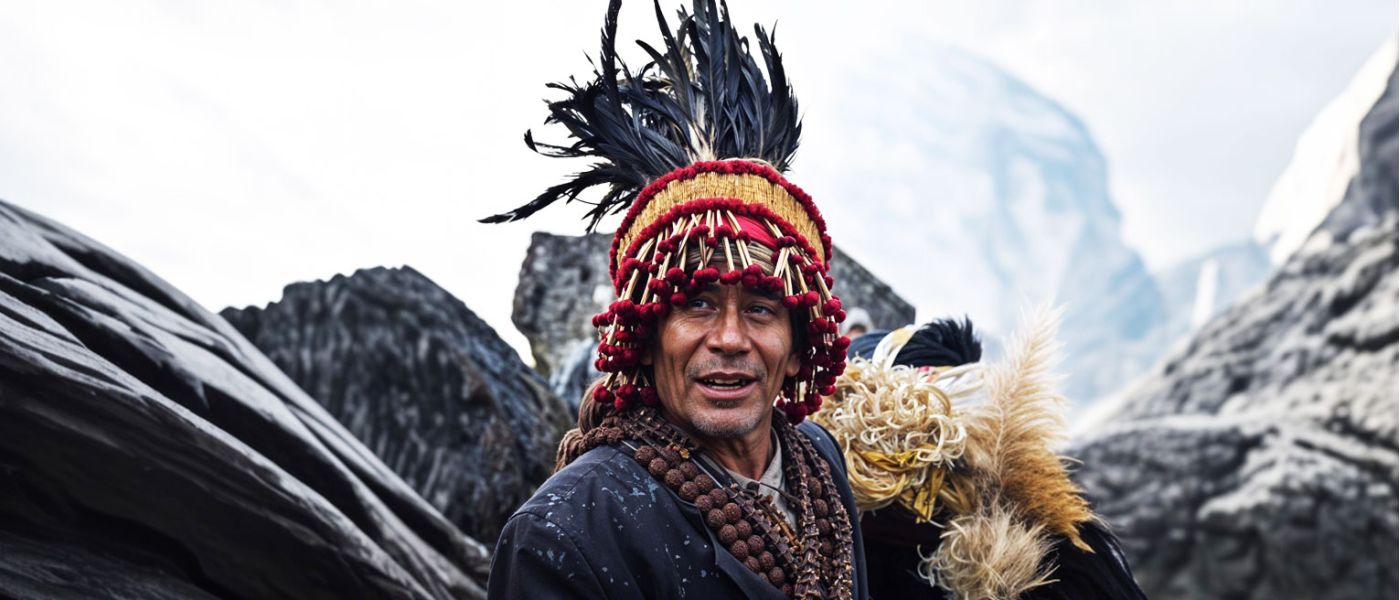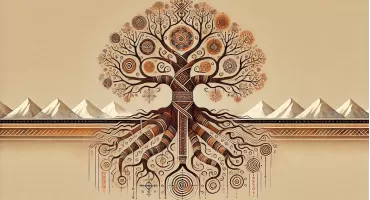Back in 2014, when I first offered my time to an organization dedicated to preserving the cultural traditions of the Kirati Khambu Rai in Darjeeling, I stepped into a world I had always carried with me, yet scarcely understood. I knew the names of our ancestors, the patterns of our migrations, the outline of our history, but not the cadence of the traditions that bound spirit to soil. I could fumble through Chamling sentences and recognize the offerings of Samkhalung during Chhowa. But the deeper aspects of my culture, the meanings behind the Mundhum, the sacred logic of the rituals, the worldview etched in symbolic actions and inherited ways of life, remained elusive.
For years I had lived comfortably within the architecture of modern life, working in a firm that developed web applications, surrounded by the glowing screens of another world. I wore Western clothes, watched American shows, thought in English, but never once doubted the fact that I was Kirati. It was a knowledge I did not question, though I rarely turned toward it. It was only through years of listening, recording, and slowly learning to see as my elders see that something shifted. The distant became intimate. The inherited became deliberate. Sure, I had always identified as Kirati Khambu, but had I truly understood what that meant? Had I, even then, possessed ethnic consciousness?

Ethnic consciousness is the lived awareness of belonging to a distinct cultural group, marked by inherited identity and a reflective understanding of its meaning, boundaries, and significance in relation to the wider world. As Fredrik Barth observed in his influential introduction to Ethnic Groups and Boundaries: The Social Organization of Culture Difference (1969), what defines an ethnic group is not the cultural content itself but the boundaries that are maintained between groups. This kind of self-awareness does not always emerge organically. It often surfaces in moments of tension, contact or marginalization. It is when a community begins to recognize its own patterns, beliefs and ways of life as markers of identity rather than just inherited customs that culture becomes conscious. This shift from living culture to self-aware identity is subtle but transformative. It turns tradition into a basis for collective strength, advocacy and survival in a world that demands clear definitions.
Here, it is crucial to understand what ethnicity truly means. It should not be mistaken for far-right notions of ethnicism, tribalism, or racial superiority. Ethnicity is a lived experience of belonging to a people defined by their unique customs, languages, and ways of relating to the world. It is the emotional and cultural attachment to traditions passed down and practiced daily. For elders and cultural stewards, the quiet erosion of this inheritance is a deep and silent wound. For the young, drawn by the pull of cities and the promise of new opportunities, such detachment may feel like freedom. Yet every language forgotten, every rite left unperformed, risks severing a vital thread in the vast tapestry of human possibility.

Ethnic consciousness often intensifies when a culture is under threat. This is a familiar pattern among indigenous peoples worldwide. As John and Jean Comaroff explain in Ethnicity, Inc., communities frequently turn to their ethnic identity as a means of reclaiming visibility and asserting agency when faced with marginalization or cultural loss. In the Darjeeling region and its surroundings, this is evident among communities near Bagdogra and Salugada. There, Kirati organizations and other tribal groups in the Duars have been actively engaged in reviving their ancestral traditions, organizing large annual festivals, and renewing their focus on language and cultural preservation with growing success.
In my experience, exclusion often plants the first seed of ethnic consciousness. When communities are overlooked by institutions, denied access to basic facilities, or left out of larger conversations, something shifts. People begin to turn inward, for survival, and to remember. Slowly, this inward turn can grow into a movement. I’ve seen it happen, where neglected languages are spoken again with care, where long-forgotten festivals are revived. These acts are quiet affirmations. Through every ritual performed, through every endangered word uttered, there’s a message being sent: We are still here.
But exclusion isn’t the only path to awareness. Sometimes it begins in far gentler ways. I’ve watched people become conscious of their roots simply by being part of a cultural organization. In spaces where shared memory is honored, a kind of camaraderie forms that nudges people to look deeper into themselves. Some join out of curiosity, others because they carry a pride in ancient ancestry. And then there are those who seem unsure at first. They may not know the rites, may not speak the language fluently, but carry a quiet, generational awareness. Over time, with every story shared, every ritual observed, they begin to see more clearly. Their journey inward doesn’t come all at once, but gradually, as they begin to understand that their identity has always been there, waiting, just beneath the surface.
At the same time, migration, urbanization, and tourism have created new conditions for reflection. When individuals leave their ancestral lands for cities or foreign countries, they often find themselves re-evaluating what it means to belong. Culture, once taken for granted, becomes a thread of memory and longing. Interestingly, tourism plays a dual role in this process. While it sometimes risks flattening culture into spectacle, it also pushes communities to examine and articulate their traditions with renewed clarity. And perhaps most crucially, cultural transmission, serves as the foundation of ethnic awareness.
Ethnicity today is often spoken of as if it were fixed and self-evident, but as scholars like Jean and John Comaroff argue, it is anything but static. Rather than a single, solid identity, ethnicity is better understood as a living process. It is a set of shared signs, languages, customs, and sentiments through which people come to recognize themselves and one another. Its meaning changes depending on history, politics, and experience.
Among the Kirati communities of the Himalayas, for instance, ethnicity is attached to oral traditions, agricultural rituals, sacred landscapes, and kinship patterns but it is also shaped by the pressures and incentives of the modern state. With the promise of recognition, representation, or access to Scheduled Tribe benefits, some individuals begin to express their ethnic identity more visibly in public, even if those same traditions are fading at home. In such cases, ethnic performance may appear strategic, but it still reflects the larger reality that identity is now being negotiated in a world where visibility matters. As modernization and state narratives press in, this once quiet identity must become conscious and, at times, even performative.
But is this really ethnic consciousness? If identity is displayed only for political recognition or material gain, can it still be called awareness in the deeper sense? This question lingers in many corners of our community, and I’ve often found myself asking it quietly when I see festival costumes worn like uniforms, or rituals performed without memory. When culture is practiced only in the open, but forgotten at home, it risks becoming a performance for the gaze of others, whether governments, researchers, or tourists.
And yet, even strategic displays can carry the seeds of something more meaningful at least among some individuals. Sometimes, performance precedes belief. A young person who joins a festival ritual out of obligation may still be moved by something glorious within it. A checkbox on a form may lead someone to ask, “What does this actually mean?”. While wearing a traditional attire, one might feel a sense of pride. Therefore, while ethnic consciousness may begin in the political, but for it to truly take root, it must become personal. Something to be experienced, remembered, lived, and slowly carried inward.

Over the years, I’ve met many such individuals who first wore their identity for convenience or recognition, but later found themselves asking profound questions. What begins as a borrowed ritual or an attendance can easily turn into an inward journey. Some start picking up books on culture and history, flipping through old photographs, or listening to the elders they once ignored. I’ve also seen people who barely spoke their mother tongue begin to search for its words again. In time, the costume becomes a memory, and the memory becomes meaning. Ethnic consciousness is not always inherited in full. Sometimes it is rediscovered, piece by piece, story by story, until what was once external becomes internal.
So, did I truly have ethnic consciousness back then, when I first began volunteering in 2014? Perhaps not in its full form. I had fragments, memories, names, rituals heard in passing, a sense of belonging that was more intuitive than articulated. What I carried might be better described as latent awareness, a quiet certainty that I was part of something older, though I hadn’t yet turned to face it fully. Over the years, through listening, reading, asking, and sometimes simply being present, that awareness grew. It matured into something more deliberate, and reflective.
But this consciousness has not come without its complications. At times, it has slowed me down and led me to question the paths I might have taken more easily if I had chosen to forget. At other times, it has grounded me. In a world that urges constant reinvention, it offers continuity. In the noise of modern life, it gives coherence. I live fully in the modern world. I embrace technology, learning, and new ways of seeing. I value inquiry, skepticism, and the pursuit of truth. These shape my thinking. My identity as a Khambu moves alongside these values. I live with both. I think with both. I carry both. This awareness has brought clarity to my perspectives. It has shown me that identity forms through engagement, memory, and lived experience. And that to move meaningfully in this world, one must first know where their feet are standing.





Leave a Reply